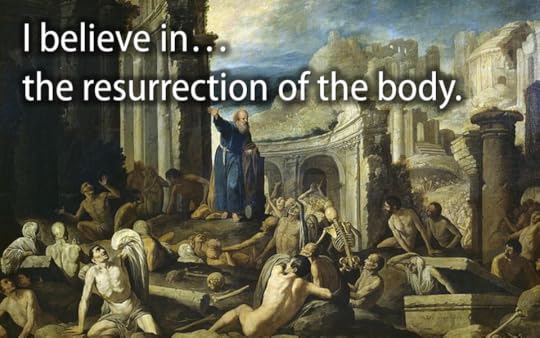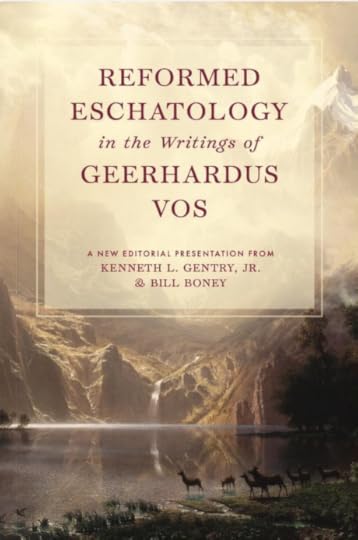VOS ON THE RESURRECTION OF BELIEVERS
 PMW 2024-072 by Geerhardus Vos
PMW 2024-072 by Geerhardus Vos
Gentry Note:
The preterist hermeneutic is a helpful tool for understanding many New Testament prophecies. But it is a tool that for some folks what has some sort of addictive power that leads them off into error. In fact, it has led hundreds of folks into heresy, even denying the historic Christian doctrine of the resurrection of the body. A helpful antidote to such confused thinking can be found in the writings of Geerhardus Vos, among others. In this two-part series, I will post a couple of major points from Vos’ “Eschatology of the New Testament.” The only changes I will make to Vos’ article is to break it into smaller paragraphs, since he wrote in a day when paragraphs were virtually book length! So, let’s get started with Vos’ observations.
Vos on the Resurrection
The resurrection of believers bears a twofold aspect. On the one hand it belongs to the forensic side of salvation. On the other hand it belongs to the pneumatic transforming side of the saving process. Of the former, traces appear only in the teaching of Jesus (Matthew 5:9; 22:29–32; Luke 20:35, 36). Paul clearly ascribes to the believer’s resurrection a somewhat similar forensic significance as to that of Christ (Romans 8:10, 23; 1 Corinthians 15:30–32, 55–58). Far more prominent with him is, however, the other, the pneumatic interpretation. Both the origin of the resurrection life and the continuance of the resurrection state are dependent on the Spirit (Romans 8, 10, 11; 1 Corinthians 15:45–49; Galatians 6:8). The resurrection is the climax of the believer’s transformation (Romans 8:11; Galatians 6:8).
Why Not Full-Preterism? by Steve Gregg
This work exposes some of the key flaws in Hyperpreterism by someone who has formally debated them. Much insightful material for those who might be tempted to forsake historic Christian orthodoxy.
For more Christian educational materials: www.KennethGentry.com
This part ascribed to the Spirit in the resurrection is not to be explained from what the Old Testament teaches about the Spirit as the source of physical life, for to this the New Testament hardly ever refers; it is rather to be explained as the correlate of the general Pauline principle that the Spirit is the determining factor of the heavenly state in the coming eon. This pneumatic character of the resurrection also links together the resurrection of Christ and that of the believer. This idea is not yet found in the Synoptics; it finds expression in John 5:22–29; 11:25; 14:6, 19. In early apostolic teaching a trace of it may be found in Acts 4:2.
With Paul it appears from the beginning as a well-established principle. The continuity between the working of the Spirit here and His part in the resurrection does not, however, lie in the body. The resurrection is not the culmination of a pneumatic change which the body in this life undergoes. There is no preformation of the spiritual body on earth. Romans 8:10, 11; 1 Corinthians 15:49; 2 Corinthians 5:1, 2; Philippians 3:12 positively exclude this, and 2 Corinthians 3:18; 4:7–18 do not require it. The glory into which believers are transformed through the beholding (or reflecting) of the glory of Christ as in a mirror is not a bodily but inward glory, produced by illumination of the gospel. And the manifestation of the life of Jesus in the body or in the mortal flesh refers to the preservation of bodily life in the midst of deadly perils.
Reformed Eschatology in the Writings of Geerhardus Vos
Ed. by Ken Gentry and Bill Boney
This is a collection of several key eschatological studies by the renowned Reformed theologian Geehardus Vos. We have modernized Vos’ grammar and syntax and updated his layout style according to modern publishing conventions (shorter sentences and paragraphs). We did this without changing any of Vos’ arguments.
For information on the upcoming Geerhardus Vos work or to pre-order it, see:
https://axeheadpress.com/pages/coming-soon-vos
Equally without support is the view that at one time Paul placed the investiture with the new body immediately after death. It has been assumed that this, together with the view just criticized, marks the last stage in a protracted development of Paul’s eschatological belief. The initial stage of this process is found in 1 Thessalonians: the resurrection is that of an earthly body. The next stage is represented by 1 Corinthians: the future body is pneumatic in character, although not to be received until the parousia. The third stage removes the inconsistency implied in the preceding position between the character of the body and the time of its reception, by placing the latter at the moment of death (2 Corinthians, Romans, Colossians), and by an extreme flight of faith the view is even approached that the resurrection body is in process of development now (Teichmann, Charles). This scheme has no real basis of fact.
[image error]Why I Left Full-Preterism (by Samuel M. Frost)
Former leader in Full Preterist movement, Samuel M. Frost, gives his testimony and theological reasoning as to why he left the heretical movement. Good warning to others tempted to leave orthodox Christianity.
See more study materials at: KennethGentry.com
First Thessalonians does not teach an unpneumatic eschatology (compare 4:14, 16). The second stage given is the only truly Pauline one, nor can it be shown that the apostle ever abandoned it. For the third position named finds no support in 2 Corinthians 5:1–10; Romans 8:19; Colossians 3:4. The exegesis of 2 Corinthians 5:1–10 is difficult and cannot here be given in detail. Our understanding of the main drift of the passage, put into paraphrase, is as follows: we feel assured of the eternal weight of glory (4:17), because we know that we shall receive, after our earthly tent-body shall have been dissolved (aorist subjunctive), a new body, a supernatural house for our spirit, to be possessed eternally in the heavens.
A sure proof of this lies in the heightened form which our desire for this future state assumes. For it is not mere desire to obtain a new body, but specifically to obtain it as soon as possible, without an intervening period of nakedness, i.e. of a disembodied state of the spirit. Such would be possible, if it were given us to survive till the parousia, in which case we would be clothed upon with our habitation from heaven (=supernatural body), the old body not having to be put off first before the new can be put on, but the new body being superimposed upon the old, so that no “unclothing” would have to take place first, what is mortal simply being swallowed up of life (5:2, 4). And we are justified in cherishing this supreme aspiration, since the ultimate goal set for us in any case, even if we should have to die first and to unclothe and then to put on the new body over the naked spirit, since the ultimate goal, I say, excludes under all circumstances a state of nakedness at the moment of the parousia (5:3).
Since, then, such a new embodied state is our destiny in any event, we justly long for that mode of reaching it which involves least delay and least distress and avoids intermediate nakedness. (This on the reading in 5:3 of ei ge kai endusamenoi ou gumnoi heurethesometha. If the reading ei ge kai ekdusamenoi be adopted the rendering of 5:3 will have to be: “If so be that also having put off (i.e. having died), we shall not at the end be found naked.” If eiper kai ekdusamenoi be chosen it will be: “Although even having put off (i.e. having died) we shall not at the end be found naked.” These other readings do not materially alter the sense.) The understanding of the passage will be seen to rest on the pointed distinction between being “clothed upon,” change at the parousia without death (5:2, 4), to be “unclothed,” loss of the body in death with nakedness resulting (5:4), and “being clothed,” putting on of the new body after a state of nakedness (5:3).
Interpreted as above, the passage expresses indeed the hope of an instantaneous endowment with the spiritual body immediately after this life, but only on the supposition that the end of this life will be at the parousia, not for the case that death should intervene before, which latter possibility is distinctly left open. In Romans 8:19 what will happen at the end to believers is called a “revealing of the sons of God,” not because their new body existed previously, but because their status as sons of God existed before, and this status will be revealed through the bestowal upon them of the glorious body. Colossians 3:3 speaks of a “life … hid with Christ in God,” and of the “manifestation” of believers with Christ in glory at the parousia, but “life” does not imply bodily existence, and while the “manifestation” at the parousia presupposes the body, it does not imply that this body must have been acquired long before, as is the case with Christ’s body. In conclusion it should be noted that there is ample evidence in the later epistles that Paul continued to expect the resurrection body at the parousia (2 Corinthians 5:10; Philippians 3:20, 21).
Gentry conclusion
In my next posting, I will present Vos’ study on the resurrection-body itself. If you don’t believe, just check back and I will prove it!
Kenneth L. Gentry Jr.'s Blog
- Kenneth L. Gentry Jr.'s profile
- 85 followers



